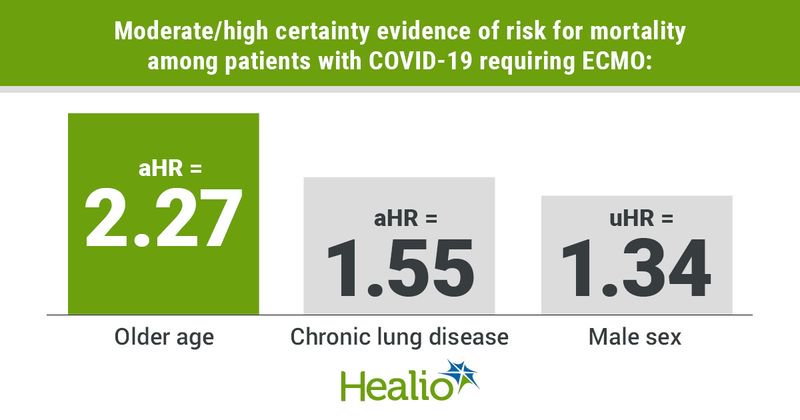Patient, pre-cannulation disease factors heighten mortality risk in COVID-19 ECMO patients
A higher likely risk for mortality in COVID-19 patients receiving extracorporeal membrane oxygenation was found in older patients, men and those with chronic lung disease, according to study results published in Lancet Respiratory Medicine.
Further, an extended duration of symptoms and invasive mechanical ventilation, as well as heightened driving pressure and partial pressure of arterial carbon dioxide, increased the risk for in-hospital death in this patient population, according to researchers.

“The prognostic factors identified highlight several well established principles of effective acute respiratory distress syndrome [ARDS] and extracorporeal membrane oxygenation [ECMO] care: the importance of patient selection, the effect of injurious lung ventilation and the potential opportunity for greater centralization and collaboration in the use of ECMO across centers and regions,” Alexandre Tran, MD, MSc, FRCSC, chief resident in the division of critical care and department of medicine at University of Ottawa, and colleagues wrote. “We advocate for the careful consideration of these prognostic factors as part of a risk stratification framework when evaluating a patient’s potential indication for venovenous ECMO for the treatment of COVID-19.”
In a systematic review and meta-analysis, Tran and colleagues conducted a database search of studies published between Dec. 1, 2019, and April 14, 2022, and evaluated 42 observational cohort studies that included a total of 17,449 adults with COVID-19 ARDS requiring venovenous ECMO to determine the relationship between various prognostic factors before cannulation and the risk for in-hospital mortality.
Using meta-analyses that assessed unadjusted and adjusted odds ratios, hazard ratios and mean differences, researchers determined what factors are linked to an increased probability for death. They also used the Quality in Prognosis Studies tool to account for risk for bias and the Grading of Recommendations Assessment, Development and Evaluation approach to figure out the certainty of evidence.
Of the total cohort, 54% of patients died in the hospital.
Mortality risk factors
In terms of patient factors likely related to higher mortality, researchers observed high certainty evidence for older age (adjusted HR [aHR] = 2.27; 95% CI, 1.63-3.16) in five studies and moderate certainty evidence for chronic lung disease (aHR = 1.55; 95% CI, 1.2-2) in three studies and male sex (unadjusted OR [uOR] = 1.34; 95% CI, 1.2-1.49) in 26 studies.
An elevated risk for mortality was also linked to four pre-cannulation disease factors including high certainty evidence for increased driving pressure (aHR = 2.36; 95% CI, 1.4-3.97) in two studies and moderate certainty evidence for longer duration of symptoms (unadjusted mean difference, 1.51 days; 95% CI, 0.36-2.65) in eight studies, increased partial pressure of arterial carbon dioxide (unadjusted mean difference, 4.04 mm Hg; 95% CI, 1.64-6.44) in 16 studies and extended invasive mechanical ventilation duration (uOR = 1.94; 95% CI, 1.4-2.67) in six studies.
Lastly, researchers observed that higher mortality was likely linked to low patient center volume/less prior ECMO experience (adjusted OR = 2.27; 95% CI, 1.28-4.05) based on moderate certainty evidence from two studies.
Unlikely, unknown risk factors
Rather than showing a higher mortality risk, researchers found moderate certainty evidence from two studies that bacterial co-infection did not have an impact on mortality (aHR = 1.03; 95% CI, 0.88-1.22).
Researchers noted low certainty evidence and/or increased risk for bias when evaluating several factors for an association with mortality including obesity, immunocompromised status, decreased PaO2/FiO2, increased plateau airway pressure, need for pre-cannulation renal replacement therapy, proning before ECMO, positive end-expiratory pressure, tidal volume, respiratory system compliance and peak airway pressure.
“We took a pragmatic approach to the inclusion of studies and grouping of variables, allowing for use of the definitions in the included studies to maximize data yield and utility,” Tran and colleagues wrote. “However, the appropriate interpretation of results is supported by confirmation after clinically important sensitivity analyses and characterization of certainty using GRADE methodology.”
This study by Tran and colleagues provides insight on factors that likely heighten the risk for mortality; however, most of the pre-cannulation disease factors they found were either from a small sample or not confirmed in an adjusted analysis, according to an accompanying editorial by Marco Giani, MD, researcher at the School of Medicine and Surgery at the University of Milano-Bicocca, and Emanuele Rezoagli, MD, PhD, assistant professor of anesthesia, critical care and pain medicine at the University of Milano-Bicocca. Due to this, Giani and Rezoagli wrote that clinicians and patients should take caution when interpreting the findings.
“Several questions remain regarding the prognostic role of spontaneous breathing, noninvasive and mechanical ventilation before ECMO,” Giani and Rezoagli wrote. “For example, how to weight the effect of duration and method of noninvasive respiratory support, how to quantify the risk of patient self-inflicted lung injury and whether a threshold of time and intensity of ventilation before ECMO cannulation might not be protective with regards to survival remain unclear. Future studies are expected to shed light on these questions.”

